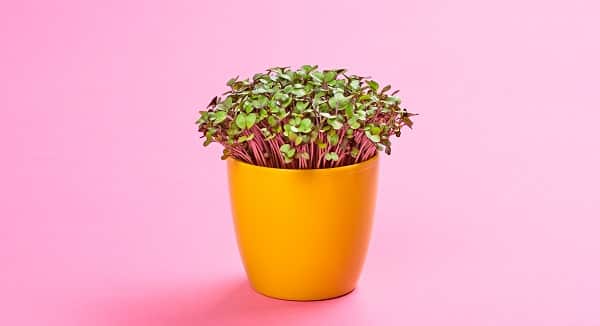A microgreen is a very young, small-leafed plant grown for its edible leaves, shoots, or stems. Microgreens are typically grown in soil but can also be grown hydroponically or in a soilless medium. Microgreens are harvested and eaten before they reach full maturity and sometimes before they even flower. Microgreens were first discovered in the 70s when farmers noticed that seeds would sprout before they planted in soil.
They are germinated greens used for garnishes and small bites in restaurants around the world. There are different varieties available, but it’s easy to grow your microgreens at home, and you can use practically any seed for them. Microgreens are a nutritious, delicious addition to any salad or sandwich. They are also more cost-effective than vegetables and much more convenient than growing your own. Microgreens are young and tender edible plants harvested before they become established, rising to their mature form. Eating microgreens can boost your immune system, improve digestion, promote better sleep, and even help purify your blood.
Here Are Some Microgreen Varieties:
Kale Microgreen

Kale microgreens are a cultivar of the kale plant grown to harvest a small portion of the plant known as its microgreens. Microgreens are typically harvested 2–3 weeks after sowing, and consumers can eat them raw in salads or add them to various dishes. Their nutrient-dense leaves are packed with vitamins and minerals that aid in the fight against free radicals and infection and promote longevity. Plus, unlike other vegetables, kale is in the cabbage family and does not require blanching before consumption. Since kale is packed with nutrients such as calcium, vitamin A, vitamin C, and potassium, you can feel good about eating kale microgreens for your health. They are also packed with fiber, making them great for digestion.
Radish Microgreens

Many edible microgreens are out there, but one of the most unique is the radish microgreen. It is small and tender, and it has a flavor that is a bit spicy and a bit sour. It is frequently used in stir fry or added to sandwiches and salads, and you can use it in almost any way you would use lettuce or other leafy greens. Radish microgreens are rich in nutrients such as vitamin C, calcium, folic acid, potassium, and other nutrients essential to the human body. It belongs to the Brassicas family and is the most cultivated plant species. The different radish varieties have different colors, like purple, yellow, white, pink, and red. All of them have an elongated root that is often used as a spice and a vegetable.
Arugula Microgreen

Arugula microgreens are a new trend globally, and they are one of the easiest crops to grow at home. Arugula microgreens are young arugula plants harvested while they are still small and tender. The resulting foliage is bright green and has a fresh taste that resembles a mix of pepper and mustard greens. They are very costly and compact to come by, but they complement any dish. They add a nice flavor and crunch to any meal, and they are healthy for you because they are small in calories and fat. They are also rich in minerals and vitamins such as magnesium, calcium, iron. They are also excessive in vitamins c, e, and a.Microgreens are very versatile and can be added to any meal. They are used in salads, sandwiches, casseroles, stir-fries, and soups. They can also be sprinkled over popcorn and even used in smoothies.
Broccoli Microgreens

Broccoli microgreens are an exciting vegetable. They’re rich in vitamins A and C and minerals. Broccoli is a cool-season crop that’s easy to grow from seed and can be harvested in as little as 20-25 days. Broccoli, particularly the buds, are a favorite food for many backyard gardeners. The leaves and stems of the broccoli plant have a more bitter flavor.
If you regularly consume broccoli, it has been shown to protect against many diseases, including heart disease, cervix cancer, and even the common cold. Broccoli is also high in an antioxidant called sulforaphane, which has been shown to increase the number of enzymes in the liver that get rid of toxins and other harmful substances. The period of broccoli microgreens is from late May to early August. It is the best period for broccoli microgreens. Inter-planting broccoli with radish can prevent diseases caused by pathogens. In addition, the period between April and July is the ideal time to find more baby broccoli.
Basil Microgreen

Basil is one of the most common herbs grown worldwide. It’s an annual plant that can tolerate warm and rainy weather and is relatively easy to grow. Microgreens are a trendy item in today’s cuisine. Basil microgreens are an excellent snack made from any edible herb. You can use them on sandwiches, in smoothies, or just as a garnish to any dish. They’re also easy to make and add a pop of green to any meal. Most basil microgreens varieties are harvested after 10-14 days of sowing. If harvested longer, basil microgreens will develop bitterness.
Cabbage Microgreens

Cabbage microgreens are edible plants cultivated by using the seeds of cabbages. Cabbage microgreens are the most popular to be consumed as nutritious microgreens. Cabbage microgreens are very readily available and can be used in salads, sandwiches, and many other dishes that require microgreens. Cabbage microgreens are also tasty as a garnish for any dish. Cabbage microgreens are one of the healthier greens since they are low in calories and fat. They are also nutrient-dense food. Cabbage microgreens have a lot of vitamins and minerals.
Conclusion
Microgreens conclude that they are an excellent way to add extra vitamins and antioxidants to any meal and generally be grown in the home. As long as you can keep the seedlings warm enough, they can be grown year-round, and they make a significant addition to any meal.


